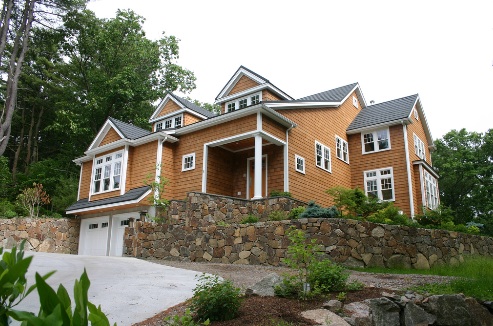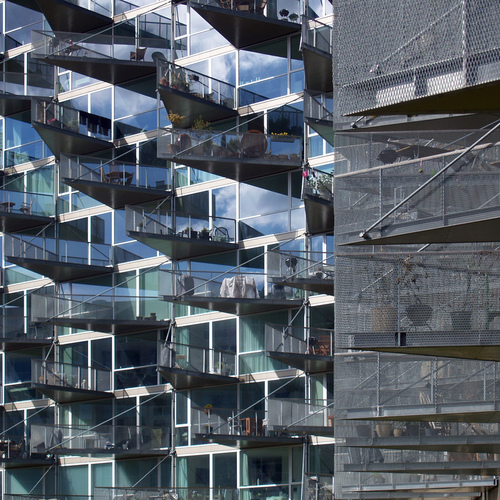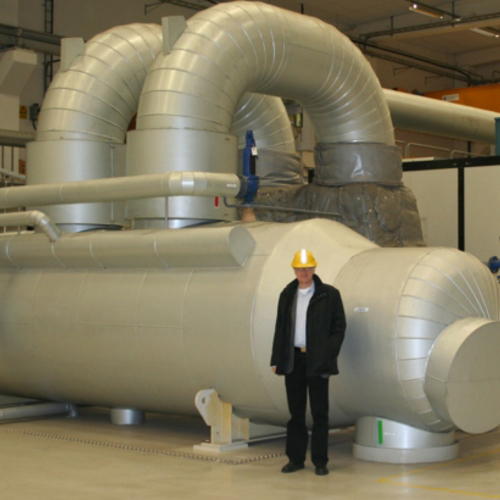
Image Credit: Cleantech Homes LLC
Image Credit: Cleantech Homes LLC The foundation walls were precast from 7000 psi concrete, Cleantech says. Walls were insulated with closed-cell foam on the inside and, on the exterior, foam board. The house features solar power and solar hot water systems. Cleantech offers tours of the house to help explain how its insulation and airtightness, and its HVAC, electrical, and plumbing systems, combine to make the building comfortable and operate efficiently. The home’s exterior features a traditional New England design, and a contemporary look inside. Tours of the house are scheduled to begin on August 5.
Cleantech Homes LLC, a three-year-old residential development and consulting company, has taken the “show and tell” principle of marketing to its logical limit and built a demonstration home that the company designed to combine energy efficiency, sustainable materials and construction practices, and traditional and contemporary aesthetics.
Located in Beverly, Massachusetts, about 20 miles north of Boston, the 4,100-sq.-ft. house on Thursday will be inaugurated into the community by the town’s mayor, William Scanlon Jr., and begin a six-month stint as an R&D lab and tour center for building professionals, students, and the general public.
The tours will not be casual walkthroughs, however. Participation costs $20 per person and must be arranged by selecting a date on the scheduling page that will be posted on the Cleantech website. Each tour is expected to take a little more than an hour and is intended to give participants a complete overview of the construction techniques, materials, appliances, and renewable-energy systems used, and how they work in concert to make the house comfortable, energy efficient, ecologically sensible, and financially manageable.
An apolitical approach
According to Cleantech, the exterior walls are insulated to R-28 with closed-cell foam and an outside layer of expanded polystyrene foam. The thermal resistance of the roof is R-42. The building is equipped with a solar power system, solar hot water, a ground-source heat pump, energy efficient lighting, and automated and remotely controlled energy-consumption and security systems. The company estimates that the house, which was among the first to qualify for the Environmental Protection Agency’s WaterSense conservation program and is aiming for LEED for Homes Platinum certification, will use half the energy of a comparably sized home built to code.
Cleantech avoids extensive use of the word green on its website because, the company says, “the use of the term, however noble it once was, has become for many utterly polarizing and highly political.” The terms high-performance and sustainable figure far more prominently in the Cleantech narrative and mission, which, the company says, includes demystifying what a high-performance, sustainably built home is.
A TV debut
The Cleantech house and concept caught the attention of renovation consultant Bruce Irving, known to many as executive producer of the “This Old House” series on PBS. Irving liked the Cleantech concept enough to cite the home as “House of the Month” on his consulting company’s website and feature it in another TV series he is producing, “This New House”, which premiered July 29 on the DIY Network. “Everywhere you turn in the building,” Irving writes on his website, “there’s something worth noting, from the 100-year metal roof to the 50-year nontoxic wood decking to the whole-house energy-use ‘dashboard’ to the ground-source heat pump. And each factor has been analyzed for its return on investment, which pushes the project beyond ‘feel-good’ to a genuine educational experience.”
We’ve asked Cleantech for a few more details about the house, including its likely listing price, and will post the information here as soon as it becomes available.
Weekly Newsletter
Get building science and energy efficiency advice, plus special offers, in your inbox.















3 Comments
Clean design
Dormer's, wings, tuck under garage, this design is not efficient, too much surface to volume. What is the expected heating and cooling load for this house?
A Cleantech response
Cleantech Homes' president, Jim Farnham, sent us the following comments:
While many of us hold a high standard for sustainability, it is important to be cognizant of the many factors involved in building a house for hopeful positive reception in the marketplace. After all, if these sustainable initiatives, as good as they may be, are not adopted by significant numbers it is of little use. Let's say that we build the ultimate in sustainable buildings without regard for capital cost, fit in the marketplace, comfort, or aesthetics. Perhaps 2-3 % of the marketplace might have interest. On the other hand, if while we are adding significant sustainable measures, we also pay attention to the other needs of the marketplace, design, aesthetics, relevance to surrounding properties, ROI, and even luxury, we have the opportunity of capturing a much larger piece of the market. I would much rather have 80% of the market adopt 30-40% in greater efficiencies, than be left with only 3% of the market adopting 60-70% efficiencies. This would also ensure a definitely path in the industry with more innovation to come.
With regard to our showcase project/learning center we address a lot of these issues inclusive of the quantifiable and also the subjective and qualitative. The heat load for the house, which measures at about 4,200 usable square feet, is 62,500 BTU/HR based on .16 air exchanges per hour via our energy recovery ventilators. The cooling load under the same parameters is about 20,000 BTU/HR. The design of the house with the north-facing driveway side, and with the dormers, effectively being at 1 1/2 stories, allows for significant insulation of the raftered part of the room space in the pertinent rooms -- via 2X10 rafter cavities. Not too mention we achieve an R value of 4 with our metal roof system -- with sealed air space between the roof material and the roof deck, which on the 1 1/2 story part of the house further helps directly insulate the conditioned living space. The south-facing side of the house by design is a full 2 stories and is inclusive of a higher percentage of windows for passive gain in the heating months. Overhangs help shade the 2nd floor windows in the summer when the sun is higher in the sky. Beyond these considerations the design of the house came to fruition for aesthetic reasons as well -- issues of scale and particularly appropriate lines pertaining to an elevated site were important factors. In summary, the paradigm shift in building sustainably involves a creative multifaceted approach, away from some of the linear thought processes that have existed for decades.
Response to the response
Jim,
Thank you for providing performance figures for this home, I do not believe this house would be considered energy efficient. I like to measure building performance in Btu's per square foot per heating degree day. This works for any climate and is a good relative measure of building performance. A minimum target of 2 Btu's/sf/hdd is very achievable even for production home builders, superinsulation will yield about 1 Btu/sf/hdd and Passive House comes in at .6 or under according to my calculations.
To calculate Btu's/sf/hdd simply take the annual heating load in Btu's divided by the house square footage divided by heating degree days for the location.
Log in or create an account to post a comment.
Sign up Log in